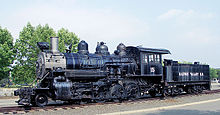Oneida and Western Railroad
| Oneida & Western Railroad | |
|---|---|
| legal form | Corporation |
| founding | August 5, 1913 |
| resolution | 1954 |
| Seat |
Oneida , Tennessee , |
| Branch | Rail transport |
The Oneida & Western Railroad (O&W) was a railway company in the north of the US state Tennessee . Starting in 1913, it built a standard-gauge railway line from Oneida west to Jamestown , some 60 km away , which was reached in 1921. The railway company mainly transported wood and hard coal, but from 1931 onwards it mostly posted losses and ceased operations on March 31, 1954.
history
In the early 20th century, the Stearns Coal and Lumber Company had logging rights in hard-to-reach old deciduous forests in western Scott County and eastern Fentress County on the Cumberland Plateau . To develop this area called Big Survey , the company planned to build a forest railroad to the Kentucky & Tennessee Railroad further north in Kentucky .
However, the Tennessee Stave and Lumber Company also had logging rights and also planned to build a forest railway into the region. On October 29, 1912, a subsidiary of this forest company, the Jamestown Railroad Company , was granted permission to build a railway line from Glenmary in southern Scott County to Jamestown. In Glenmary the company ran a sawmill; a connection to the Cincinnati Southern Railway would also have been established there . However, this route was rejected.
On August 5, 1913, permission was given to the Oneida & Western Railroad Company (O&W), which was also organized as a subsidiary of the Tennessee Stave and Lumber Company , to build a railway line from Oneida via Jamestown to Albany . In contrast to the first plans for a non-public forest railway, the statutes of O&W allowed public operation ( common carrier ) including passenger transport. The seat of the company became Oneida.
Construction of the line began from Oneida westward on November 4, 1913 and reached the Big South Fork in June 1915 . On July 1, 1916, the connection to Gernt, 15 miles from Oneida, in eastern Fentress County was put into operation, followed in 1921 by a further 23.7 km to East Jamestown . From there the track was extended to December 10, 1930 by 11.3 km to the center of Jamestown. Stockton near East Jamesville was the starting point of a short branch route called the Doss Spur from 1917 to 1925 . The timber transport initially played a major role; The recipient of the logs loaded along the route was in particular a sawmill in Verdun, immediately west of Oneida.
After large parts of the old stock of trees were cut down in the 1920s, the importance of timber transport took on a less important role for both O&W and its owners. The latter changed its name to the Tennessee Lumber and Coal Company in the middle of the decade . From the end of the 1920s, coal mines in Potter and Zenith near the border between the Fentress and Scott Counties were opened up via the railway line . However, the O&W transport volumes fell from the 1920s. From 1931 onwards, with the exception of 1948, the company posted losses every year.
In 1938 the US federal government decided to build a dam in the Cumberland River in Russell County . For the delivery of the building material for the Wolf Creek Dam , the use of the O&W route was considered. The Crown-Healy Corporation, a construction company from Illinois , therefore acquired O&W in the early 1940s. When the construction of the dam, which had been interrupted during World War II, was resumed in 1946, Crown-Healy could not win any tender. The company applied for the O&W route to be closed, but was able to find a buyer for the railway company in the Jewell Ridge Coal Company - the operator of two coal mines in Zenith.
The freight volume continued to decline in the 1940s and early 1950s; Investments in infrastructure and vehicles were not made. In 1953, O&W again applied for the cessation of operations, which was granted. The last regular train ran on March 4, 1954, followed by a last run on March 31, 1954. The railway company was then dissolved and the line dismantled.
Oneida & Western Transportation existed from 1979 to 1987, but only shared part of the name with the first O&W. The younger company provided the Louisville and Nashville Railroad vehicles for transporting coal over long distances.
vehicles
During its existence, O&W owned a total of 12 steam locomotives, all of which, with the exception of the brand new locomotive 20 purchased from Baldwin Locomotive Works in 1916, were all bought used. Locomotive 20 was sold to the Rahway Valley Railroad in 1937 and is now (as Rahway Valley 15 ) in the Steamtown National Historic Site museum .
From the 1920s, passenger and postal traffic was the O & W part of railcars delivered what first one as -M 3 designated Chevrolet tanker lorry on rails and mid-1930s, one as M-4 -defined, slightly larger railcars used has been.
Individual evidence
- ↑ a b c d Josetta Griffith: The Oneida & Western Railroad. November 12, 2009, accessed on June 6, 2020 (English, supplementary version of an article originally published in 1997 in the FNB Chronicle of the First National Bank of Oneida).
- ↑ a b c d e f Jason Duke: Tennessee Coal Mining, Railroading & Logging in Cumberland, Fentress, Overton, and Putnam Counties . Turner Publishing Company, Nashville 2003, ISBN 978-1-56311-932-3 , pp. 59 (English, 120 pp.).
- ↑ Sherman Cahal: Oneida & Western Railroad. In: abandonedonline.net. 2011, accessed June 6, 2020 .
